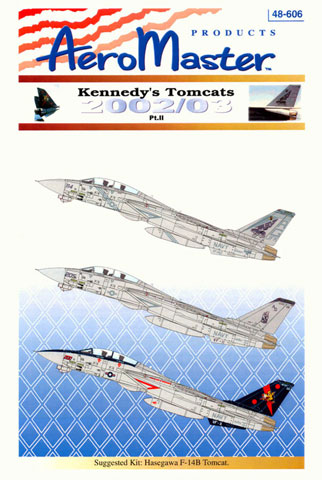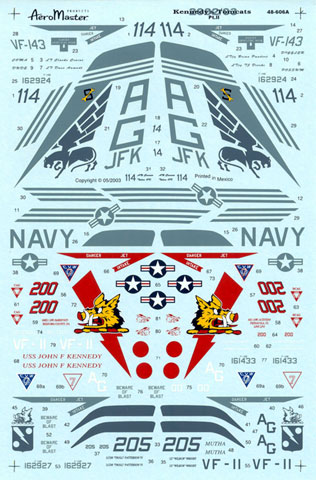|
 Kennedy's
Tomcats Kennedy's
Tomcats
2002/03
Part II
AeroMaster
Decals
|
S u m m a r y
|
| Catalogue
Number: |
AMD 48-606 - Kennedy's
Hornets 2002/03 Part II |
| Scale: |
1/48 |
| Contents and Media: |
Waterslide decals plus instructions and notes |
| Price: |
USD$8.96
from Squadron.com |
| Review Type: |
FirstLook |
| Advantages: |
Perfect register; thin;
minimal carrier film; comprehensive stencil data; good
instructions with top, bottom and plan views; |
| Disadvantages: |
|
| Recommendation: |
Recommended |
Reviewed
by Rodger Kelly

HyperScale is proudly sponsored by
Squadron.com
|
48-606 is the second sheet in
AeroMaster's coverage of the fighter and attack squadrons of Carrier
Airwing Seven (CVW-7) whilst they were based aboard the USS John F Kennedy
during the air war over Afghanistan. Unusual for a modern day airwing,
CVW-7 has two F-14 squadrons.
The sheet provides markings for
three F-14Bs, one from VF-143 'Pukin Dogs' and two from VF-11 "Red
Rippers":
 Bureau
Number 162924, modex 114 of VF-143. The aircraft is finished in the
standard F-14 Tactical Paint Scheme (TPS) of FS36320 dark ghost grey over
FS36375 light ghost grey. Whilst the markings are all lo-viz they are
quite comprehensive and spectacular. They consist of: Bureau
Number 162924, modex 114 of VF-143. The aircraft is finished in the
standard F-14 Tactical Paint Scheme (TPS) of FS36320 dark ghost grey over
FS36375 light ghost grey. Whilst the markings are all lo-viz they are
quite comprehensive and spectacular. They consist of:
-
114 modex for the nose
and wing flaps with a further smaller set for the inside of the rudders.
-
Three diagonal stripes
incorporating lo-viz national insignia for the nose with a second set
without the national insignia for the intake mounted drop tanks.
-
VF-143 scripts for the
ventral strakes.
-
A one piece decal for
the outer sides of the vertical stabilizers that include the fin cap,
three horizontal lines that span the entire cord of the stabilizer,
VF-143's squadron insignia, Safety S and Golden Spanner award. The grey
fin caps for the inner surfaces are also supplied as a decal.
-
AG airwing identifiers
with "JFK" for the rudders.
-
Pilot's, RIO's and Plane
Captain's names for the canopy rails and nose gear doors respectively.
-
NAVY titles and Bureau
number blocks for the rear fuselage.
- Intake warnings, ejection seat
triangles, and arrestor hook warnings.
Bureau Number 162927, modex 205 of
VF-11. The aircraft is finished in the F-14 TPS of FS36320 dark ghost
grey over FS36375 light ghost grey. The markings and consist of:
-
205 modex for the nose,
wing flaps and nose gear doors with a further smaller abbreviated 05 for
the outer faces of the rudders.
-
VF-11 scripts for the
ventral strakes.
-
VF-11's squadron
insignia for the outer faces of the vertical stabilizers.
-
Dark grey fin caps.
-
AG airwing identifiers
for the rudders.
-
CVW 7 scripts for the
base of the vertical stabilizers
-
Pilot's, RIO's and Plane
Captain's names for the canopy rails.
-
USS JOHN F KENNEDY
scripts for the leading edges of the wings.
-
NAVY titles and Bureau
number scripts for the rear fuselage.
- Intake warnings, ejection seat
triangles, and arrestor hook warnings.
Bureau Number 161433, the CAG bird
of VF-11 Whilst the aircraft is finished in F-14 TPS of FS36320 dark
ghost grey over FS36375 light ghost grey it bears a little colour in the
form of dark blue vertical stabilizers, rudders, ventral strakes, canopy
and anti-glare. No FS number is given for the dark blue. The markings and
consist of:
-
200 modex in red for the
nose, wing flaps and nose gear doors with a further smaller abbreviated
00 for the outer faces of the rudders.
-
VF-11 scripts for the
ventral strakes in white.
-
Large full-colour VF-2
squadron insignia for the outer faces of the vertical stabilizers that
are placed over the top of a red lightning bolt with a further two red
spots to complete the insignia.
-
AG airwing identifiers
in white for the inner surfaces of the vertical stabilizers.
-
Full colour CVW-7
insignia, also for the inner surfaces of the vertical stabilizers. Two
sets of insignia are provided, with one set being a two-part decal to
avoid register problems.
-
Pilot's and RIO's names
for the canopy rails in white.
-
Plane Captain's name in
red for the nose gear door.
-
USS JOHN F KENNEDY
scripts in red for the leading edges of the wings.
-
NAVY titles and Bureau
number scripts and arrestor hook warnings for the rear fuselage in grey.
-
Intake warnings,
ejection seat triangles in red.
-
A set of hi-viz national
insignia.
- Small VF-11 zaps in red for the
intake mounted drop tanks.
A colourful bird to say the
least.
The placement guide is a departure
from AeroMaster's norm. Whilst it still shows colour profiles it also has
several colour photographs of each of the options – nice stuff! A further
innovation is that the inside of the header sheet contains a very complete
explanation on the employment of the F-14s of CVW-7 during its Afghanistan
cruise. It gives details of how the aircraft were configured and what
ordnance was carried on what station as well as a discourse on LANTRIN and
TARPS pods. I for one am glad to see this sort of information provided in
a decal sheet as it gives you a fuller understanding on how the F-14 is
used without having to refer to other publications – a one-stop shop!
The decals themselves have been
printed in Mexico. Everything is in perfect register and there is minimal
carrier film around each subject. I have used Aeromaster decals that have
been printed in Mexico before. Whilst they are not as easy to use as
Microscale decals they do work well if you use patience and settling
solution. If you are going to do the VF-143 option I would cut the
one-piece vertical stabilizer decal into several smaller ones to save you
some anguish.

The decal sheets (there are two of
them) the placement sheet and the header are packed in a clear plastic
zip-loc bag.
The recommended kit is the
Hasegawa one.
Recommended.
Thanks to AeroMaster
/ Eagle Strike
Products for the review sets
On-line sales are available from the
AeroMaster Products /
Eagle Strike Productions web site.
Review TextCopyright © 2003 by
Rodger Kelly
This Page Created on 27 August, 2003
Last updated
11 August, 2006
Back to
HyperScale Main Page |
Home | What's
New | Features
| Gallery |
Reviews | Reference
| Forum
| Search